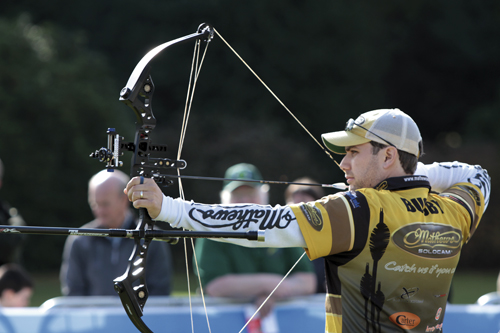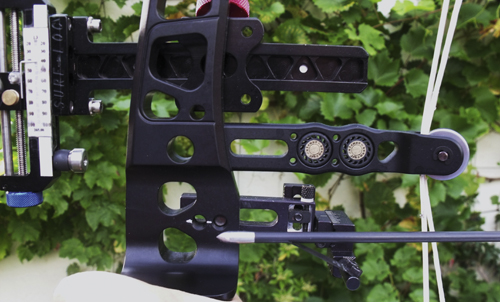Over my years as a coach and competitor I have had more and more people ask me to explain why I have used an overdraw on my bow and how it would affect their set up. I have been using an overdraw on and off now for a few years, its something that I know works, but traditionally I hadn’t put too much thought into how and why, so after doing some research and based on my own experience this is what I have found.
Firstly I need to explain what an overdraw is; an overdraw moves the contact point of your arrow (eg. the prongs of the blade) behind the throat of the grip of your bow. The amount of overdraw you have is almost infinitely variable although World Archery has a maximum allowable overdraw measurement of 6cm measured from the throat of the grip.
There are several reasons for using an overdraw, the most obvious being that you can shoot shorter and therefore stiffer arrows. This would allow you to possibly drop an arrow spine, making your arrows lighter and therefore faster; helping you to hit longer distances or shorten your sight tape for field. The addition of an overdraw can also have an effect on your current choice of arrow spine; for every inch of overdraw you shoot with, it will weaken your arrow spine by around the same amount as adding 3-4 pounds of draw weight to your bow.
But as with everything in archery, there is more to the overdraw than immediately meets the eye.
Back in the 1980s it became popular for compound archers to set their arrow rests behind their grip in order to reduce the negative effects of torque on the bow. Many people will torque their bow to a degree. If this torque is consistent their results will not be adversely affected and they may never notice any effects, but if for any reason they apply a slightly different amount of torque than usual the arrow may hit left or right of the group. You can see how much bow hand torque affects your shot by gently gripping and twisting your bow once at full draw, aim as usual and make the shot, you will most likely find that the arrow shot while torquing the bow will hit further left or right (depending on which way you twisted the bow) than your other arrows, this is not always the case but certainly the majority of people who try this will see a difference.
This is where the use of the overdraw comes in; there are several explanations to how an overdraw removes the effects of bow hand torque, one says that if the contact point of the arrow is directly above the archers wrist, the wrist being the point where most of the negative force is coming from, this will lessen the effect of the torque. I can see how this theory came around and to this day it is used as a perfectly credible way of explaining how the overdraw works.
Another theory states that if the bow is torqued say to the right, there will be a rest position behind the grip that will reposition the arrow an equal distance to the left therefore cancelling out the right hand movement; a kind of equal and opposite reaction. From my view point I feel that both these theories are explaining the same affect and actually support each other, so whichever theory sits better with you is fine.
This means that there is a critical point, a “sweet spot”, to be found between the bow and the contact point of the arrow that can remove the effects of the torque, but where exactly is this point? Unfortunately the exact point you would need to position your rest differs between bows, arrows and archers. I’m not saying that no two people will find the same sweet spot but in order to make sure you are getting the full effects of the overdraw you really need to work it out for yourself and your own kit.
In order to try out an overdraw rest you will first need an overdraw bracket or an arrow rest with a long mount; there are several models of rest on the market including some that are designed to fit around Hoyt’s Tec bar, this is something to be careful about when purchasing an overdraw as some will not fit Hoyt bows with this feature. The main manufacturers who are supplying overdraws are; Trophy Taker, Brite Sight and AAE, there are also other after market brackets available to help you convert your current rest, just be sure that they will fit and that they look sturdy.
Start by fitting the rest as you would a regular one, with the contact point in the position you would normally have it. Once you have fitted your overdraw you need to set up the rest, again you should do this as you normally would using your usual tuning methods. Once you have everything tuned it is time to set up the overdraw. The first thing to do is to choose a shooting distance that is comfortable for you, one you know you get fairly consistent results at, then shoot two or three arrows using your usual technique. Next, grip your bow in a way that allows you twist it slightly at full draw. Draw the bow and aim as usual but this time twist or torque the bow so that your long rod is pointing to the right – be careful when doing this that you don’t twist it too far as this could cause the string to slip off the cams. Make as good a shot as possible and repeat this another two or three times. Finally, do the same thing only this time twisting to the left. You will notice that, as you would imagine, the arrows shot whilst twisting to the right hit right and vice versa, which is the usual result.
Now move the rest back towards you, remembering to keep your adjustments small. Once you have done this, re-shoot the test as before and check your results. Keep making these adjustments until all the arrows you shoot hit more or less in the same place. It’s not always easy to make the best shots whilst deliberately torquing the bow, so if you feel that some of your shots were badly aimed try to discount them from your results and if in doubt re-shoot that end. You may find a point where the arrows shot whilst torquing your bow to the right actually hit left and again vice versa, which means that you have moved the rest too far back. Try moving it forward a bit and re-test, this opposite effect I feel highlights what a powerful tool the overdraw can be.
As with all things though, there are pros and cons, I have spent enough time going over its good points but there are downsides to having your rest set so far back; The most obvious is that the further away the arrow contact point is from your grip, the greater effect any movement you make will have on your arrows, this is clear to see in watching the end of your long rod whilst shooting, it will always look as if it is moving more than your scope or bow, this is an exaggerated example but the same principles will apply to your rest. Because adding an overdraw could have the effect of making your bow less forgiving, extra care should also be taken when shooting shortened arrows – should you choose to take advantage of this option. It is important to ensure that the arrow does not come off the rest when the bow is being drawn back, as if it does it’s the point that will most likely be behind your hand upon release!
Since the 1980s the use of the overdraw has waxed and waned in popularity, with many people feeling its negative points outweigh its positive. However, over the years it has picked up its fair share of fans, and notable international archers have had many tournament victories with one. An overdraw is not for everyone, personally I have found it a useful tool and have had many successes with it, so whether you think an overdraw is for you or not, it may be worth trying one out to see for yourself the difference it can make.




Explicit, precise and to the point. Excellent pointers and I would add only one comment. Keep your safety in mind. Make sure your overdraw is equipped with a guard to protect your bowhand in case the arrow comes off the rest for whatever reason. This is a must and not negotiable…
Hey would you mind sharing which blog platform you’re working with?
I’m looking to start my own blog soon but I’m having a tough time selecting between BlogEngine/Wordpress/B2evolution
and Drupal. The reason I ask is because your layout seems different then most blogs and I’m looking for something unique.
P.S My apologies for getting off-topic but I had to ask!
I shoot traditional so to me overdraw means pulling my 70# longbow back behind my Ear as a joke to poke fun at my non archer friends and then Icing my shoulder at home if I do it more than once. =P